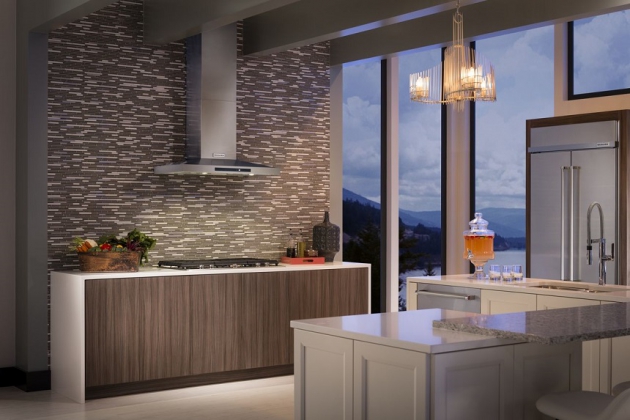Ventilation is crucial in a kitchen. A good ventilation hood will not only carry away steam, but also odors and grease that could compromise your kitchen comfort. Most kitchen ventilation hoods can be divided into one of five types. Here we’ll explore these in more detail, to help you make an informed decision for your new kitchen.
Under Cabinet Hoods
This is the most common form of ventilation hood on the market. This popularity is due to the compact size and affordability. Under cabinet hoods are mounted beneath any cabinets set above the stove with a simplistic and versatile design that can be easily incorporated into different kitchen styles. This type of hood requires ducting through the cabinet above, or through a nearby exterior wall to prevent grease and oils circulating around your kitchen.
Wall Mounted Hoods
Wall mounted hoods are a great option to create a statement in your kitchen space. This type of hood is often installed above the stove in place of any cabinetry, to create a distinct design element. The main advantage of wall mounted hoods is that the fan circulates air to reduce bacterial build up and mold on cooking areas including countertops, quickly eliminating fumes and odors.
Island Hoods
Island hoods are best used with larger, pro style ranges located on a kitchen island. This type of hood can withstand the extra demands created with additional burners, and the venting system can add a sophisticated touch to your cooking space aesthetic. Island hoods are available in different styles and colors to allow you to add personality to your kitchen design. Island hoods are also very effective at dispersing grease and steam away from the kitchen to prevent condensation and acids causing cabinet damage.
Downdraft Hoods
A downdraft hood is also a common feature for kitchen islands. The hood is hidden inside the cooktop, popping up along the back of the range on a horizontal angle to reduce steam. Downdraft hoods pill fumes down to beneath the floor taking them out of the home. This type of ventilation system is ideal for those who don’t want to install a larger overhead unit that takes up space in the kitchen, but it can still decrease discoloration, peeling and mildew on floors, walls and cabinets due to moisture.
Custom Hoods
A custom hood is a great option if you don’t want to be restricted to certain design options. Custom hoods can work ventilation into your kitchen landscape more organically. The power source and hood inserts are concealed in the cabinetry to create a custom approach.
Choosing the Right Hood for Your Kitchen
There are a number of factors that need to be considered before you make your final purchase decision. These include:
- The Exhaust System: You will need to assess whether you want a vented system that channels air out of the home or a non vented system where the air is cleaned and filtered before being returned to the kitchen. Your kitchen location will determine which is the most appropriate choice. If your kitchen does not have an exterior wall, you may struggle with a vented system, as the ducts will need to channel the air out of your home. It becomes more complicated and expensive, the further you are from an exterior wall.
- Your Layout: Your layout will need to be assessed to determine what space you have and which type of hood will work best. Generally, hoods are mounted 24 to 30 inches above a cooktop, but some hoods do have different requirements.
- Noise: Another consideration is noise. More powerful hoods are likely to produce more noise when in use. This can be problematic if you have an open plan layout, where you’re likely to disturb your family members every time you use the hood.
If you’re considering a new kitchen hood, you can explore your options with this online collection or speak to a home appliance professional for expert help and guidance.

